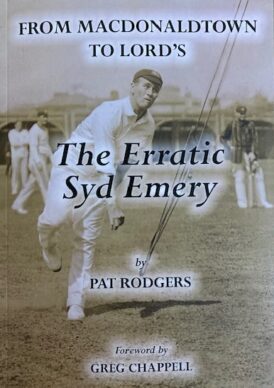From Macdonaldtown To Lords: The Erratic Sad Emery
Martin Chandler |Published: 2025
Pages: 130
Author: Rodgers, Pat
Publisher: The Cricket Publishing Company
Rating: 4.5 stars

Syd Emery played four Test matches, two each against England and South Africa, and all of them in the ill-starred Triangular Tournament of 1912. He took five wickets at 49.80, so achieved little in purely statistical terms, although the deliveries with which he bowled Jack Hobbs and ‘Plum’ Warner at Lord’s were lauded in much the same way that Shane Warne’s ‘Ball of the Century’ to Mike Gatting in 1993 was.
Which tells you that Emery was a right arm wrist spinner. He had an unusual action, bowled at something approaching medium pace and spun the ball prodigiously. In doing so, like the majority of his ilk, he sacrificed accuracy in his effort to ensnare his opponents hence the appearance of the adjective erratic in the title of his biography.
Emery was 26 when he arrived in England and only 18 months later his First Class career was over. He was selected for two Sheffield Shield matches in 1912/13 and, after touring North America with Austin Diamond’s Australian side between May and September 1913, he was not seen in the First Class game again. Emery returned to what proved to be a difficult and at times traumatic everyday life and although he was certainly not lost to cricket his spell at the top was well and truly over. He lived on until 1967 when, at 81, he passed away without descendants.
So it is in some ways a surprise that, 112 years on from his brief Test career, someone has chosen to write Emery’s biography. But then again the writer is Pat Rodgers, a man whose record demonstrates just how much he enjoys researching the life and times of Australian cricketers of this era, and the publisher is Ronald Cardwell, another man fascinated by the same subject and who, as he explains in his introduction to the book, as a 13 year old met Emery shortly before the latter’s death and even at that tender age demonstrated such a passion for cricket history to the old man that he was gifted the scrapbooks that covered Emery’s cricket career.
In researching his subject Rodgers has gone back to a time before Emery was born to look at his roots, and he has also looked into the history of Macdonaldtown, the suburb of Sydney where he was born and brought up. Clearly not the most salubrious of residential locations Macdonaldtown achieved considerable notoriety as a result of the activities of an infamous baby farming couple and was renamed Erskineville in 1893 as it sought to escape its past reputation.
Emery did not come from a cricket playing family, but his talent was such that his stock rose steadily and his achievements in Grade cricket were reported extensively thus enabling Rodgers to built up a picture of the way in which Emery approached the game.
There is much of interest in Emery’s off field life as well. He was involved in a few controversies in his time, not least in relation to the poor behaviour of some of the 1912 tourists (although Emery seems to have been by no means the worst offender). Outside the game he was, perhaps surprisingly, a Freemason and that leads to an interesting digression for Rodgers and, I suspect, will have given him a few ideas for future projects.
In time Emery did marry although, as noted, it was not a marriage blessed with children. The lives of the rest of Emery’s family are followed as best Rodgers can, particularly younger brother Victor who was very much the black sheep of the family.
The problem with some excellent researchers is that they are not particularly good writers, and as a result their narratives tend to lack colour and their books can become simple statements of fact that at times lack context. By the same token some gifted writers sometimes lack the passion or diligence to research their subjects as fully as they should. Fortunately for his readers Pat Rodgers is accomplished in both disciplines, and the result is a an account of Emery’s life that wants for nothing. Add to that a publisher who knows how to put a high quality publication together and you have, for those interested in the subject, a must have book.






Leave a comment